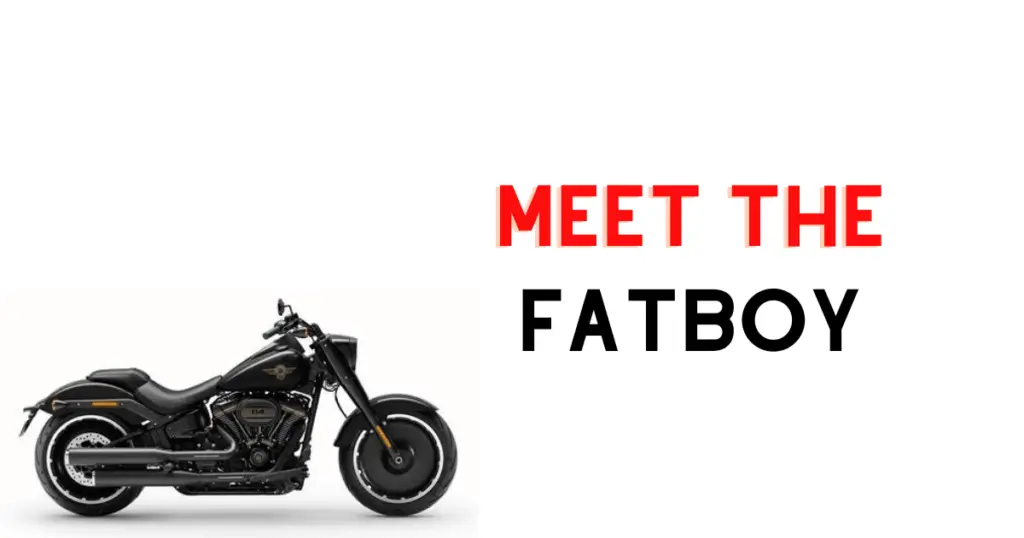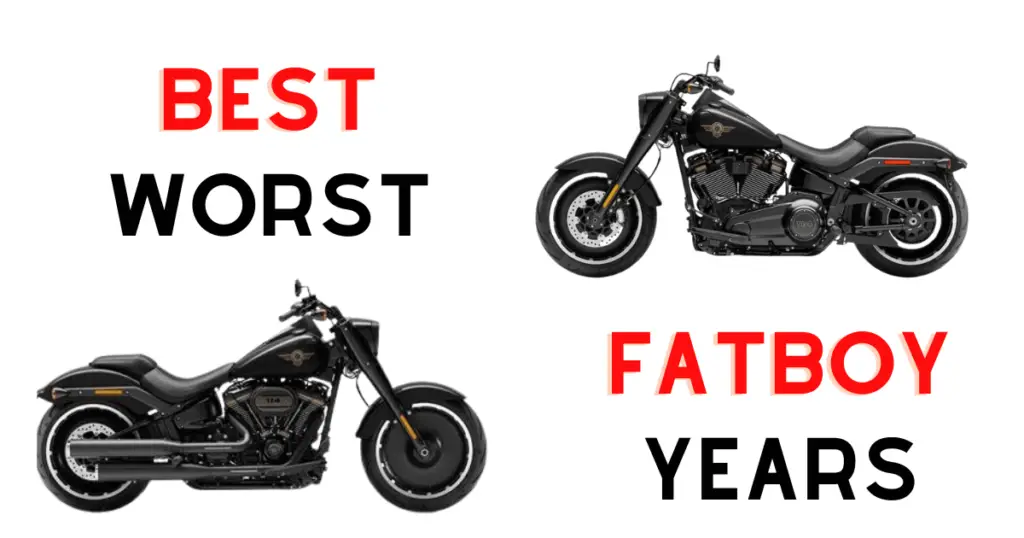If you’re in the market for a Harley-Davidson cruiser, you might be considering the Fat Boy. This iconic motorcycle has been a popular choice for riders since its introduction in 1990. However, not all Fat Boy years are created equal, and there are some you might want to avoid.
According to the information gathered in my research, there are certain Harley Fat Boy years to avoid. These include the 2000 and 2001 models, which had fuel delivery system problems that caused fuel leaks. The 2002 model also had issues with the fuel system, as well as problems with the transmission.
While these issues might be a cause for concern, it’s important to note that not all Fat Boy models are problematic. In fact, there are many years that are highly regarded by riders and experts alike. So, if you’re considering a Fat Boy, it’s important to do your research and make an informed decision – or, you know, you can read this article and go good to go! Let’s keep moving.
Related read: Round ‘Em Up: What Year Harleys To Avoid? (Full Overview)
Introduction to Harley’s Fatboy

If you’re looking for a motorcycle that’s iconic, stylish, and powerful, the Harley Fatboy is definitely a bike to consider. The Fatboy has been a fixture in the Harley-Davidson lineup since its inception in 1990, and it has remained one of the most popular cruiser motorcycles on the road.
The Evolution of the Fatboy
Over the years, the Fatboy has undergone some changes, but it has always maintained its classic look and feel. The original Fatboy featured a chrome front fork, solid disc wheels, and a modern look that set it apart from other motorcycles on the road. Today’s Fatboy still features these defining characteristics, but it has also been updated with modern technology and styling.
Defining Characteristics of the Fatboy
One of the most defining characteristics of the Fatboy is its solid disc wheels, which give the bike a powerful and muscular look. The chrome front fork is another iconic feature of the Fatboy, and it adds to the bike’s overall style and presence on the road.
The Fatboy is also known for its modern look, which combines classic Harley-Davidson styling with contemporary design elements. This gives the bike a unique and timeless appeal that riders of all ages can appreciate.
Overall, the Harley Fatboy is an iconic cruiser motorcycle that has earned its place in motorcycle history. With its powerful engine, stylish design, and classic features, it’s no wonder that the Fatboy remains one of the most popular motorcycles on the road today.
Common Problems Found in Fatboys and Their Solutions
Harley Fatboy owners have reported several common problems over the years. Some of these include:
- Transmission issues: Some Fatboy models have experienced transmission issues, such as slipping gears or difficulty shifting. Regular transmission fluid changes can help prevent these issues.
- Oil leaks: Oil leaks are a common problem with Harley Davidson motorcycles, including the Fatboy. Regular oil changes and inspections can help prevent leaks.
- Death wobble: This is a term used to describe a violent shaking of the front end of the motorcycle at high speeds. It can be caused by several factors, including worn tires, loose bearings, or improper suspension settings.
- Electrical problems: Harley Davidson motorcycles are known for their complex electrical systems, and the Fatboy is no exception. Common electrical problems include blown fuses, faulty wiring, and dead batteries.
- Clutch problems: Some Fatboy models have experienced clutch problems, such as slipping or sticking clutches. Regular clutch fluid changes and inspections can help prevent these issues.
Notable Fatboy Model Years

When it comes to the Harley Fatboy, there are a few model years that stand out for different reasons. Here, we’ll take a closer look at some of the best and worst years for this iconic motorcycle.
Best Year Harley Fatboy
One of the most beloved model years for the Harley Fatboy is 1990. This was the first year that this bike was introduced, and it quickly became a favorite among riders. With its classic styling, powerful engine, and comfortable ride, the 1990 Fatboy set the standard for all future models. Later, in 2006, the Fatboy was furthered refined with a new powerplant that revolutionized the model.
2006: The Year of Refinement
Reasons for Recommendation: The 2006 Harley Fatboy is often cited as a great year due to significant improvements in performance and reliability. This year marked the introduction of the 6-speed Cruise Drive transmission, which provided smoother shifting and better highway cruising capabilities. Additionally, the 2006 model benefited from the Twin Cam 88B engine, known for its robust performance and reliability. The combination of these features, along with the classic Fatboy styling, made the 2006 model a standout year.
Harley Fatboy Years to Avoid
While there have been many great years for the Harley Fatboy, there are also a few that you should avoid. One of the worst years for this bike was 1999. This model year was plagued by mechanical issues, including problems with the engine and transmission. Other years to avoid include 2000, 2018, and 2022.
2000 and 2001: Fuel Injection Woes
- Specific Issues: The 2000 and 2001 model years experienced issues related to their fuel injection systems. Riders reported problems with the bike’s ability to maintain consistent fuel delivery, leading to rough idling and occasional stalling. These issues were partly due to the early adaptation of electronic fuel injection (EFI) systems in motorcycles, which were still being refined for optimal performance and reliability.
2002: Continuing Fuel System and Transmission Troubles
- Specific Issues: The 2002 Fatboy continued to face challenges with its fuel system, similar to the 2000 and 2001 models. Additionally, this year introduced transmission problems, where riders experienced difficulties with gear engagement and unexpected shifting. These transmission issues were attributed to defects in the transmission’s internal components, affecting the overall riding experience.
2018: Quality Control and Reliability Concerns
- Reasons for Avoidance: The 2018 model year is noted for concerns related to quality control and reliability. Specific issues included electronic system malfunctions, such as problems with the ABS and infotainment systems. There were also reports of mechanical issues, including premature wear of certain components. These problems suggested a dip in the manufacturing standards for which Harley-Davidson is known.
2022: Modern Complaints
- Reasons for Avoidance: General feedback from the rider community points to dissatisfaction with the integration of modern technology and the bike’s overall performance. I recommend you thoroughly research and consider newer models’ long-term reliability and performance records.
Recalls and Service Advisories To Be Aware Of
Harley Davidson has issued several recalls and service advisories over the years for the Fatboy. These include:
- 2014-2015 models: A recall was issued for a faulty clutch master cylinder that could cause the clutch to fail.
- 2018 models: A recall was issued for a faulty fuel tank that could leak fuel.
- 2020 models: A service advisory was issued for a potential issue with the rear brake light switch.
If your Fatboy is affected by any of these recalls or service advisories, contact your local Harley Davidson dealer to schedule a repair.
Buying Guide For A Fatboy
If you’re in the market for a used Harley Fatboy, there are a few things you should keep in mind to ensure you get the best value for your money. Here are some tips to help you find a well-maintained Fatboy that will give you years of enjoyment.
What to Look for in a Used Fatboy
When inspecting a used Fatboy, there are several things you should keep in mind. First, make sure the bike has been well-maintained. Look for signs of regular oil changes, and check the tires, brakes, and other critical components to ensure they are in good condition. If the bike has been neglected, it could be a sign of more significant issues that could end up costing you more in the long run.
Another important factor to consider is fuel efficiency. While Harley Fatboys are not known for their fuel efficiency, newer models tend to be more fuel-efficient than older ones. If you plan on using your Fatboy as a daily driver, you may want to consider a newer model that will save you money on gas.
Understanding the Value Behind The Bike
When it comes to pricing, there are a few things to keep in mind. First, the year and model of the Fatboy can impact its value. As we saw in our research, some years are known to have more mechanical issues than others, so it’s essential to do your research before making a purchase.
Additionally, the condition of the bike can also impact its value. A well-maintained Fatboy with low mileage will likely be more expensive than one that has been ridden hard and put away wet. Keep in mind that you may need to pay more upfront for a bike in good condition, but it will likely save you money in the long run by avoiding costly repairs.
To help you better understand the value of a used Fatboy, consider using a pricing guide or consulting with a knowledgeable mechanic or Harley dealer. They can help you determine what a fair price is for the bike you’re interested in and provide additional insight into its condition and history.
By keeping these tips in mind, you can find a well-maintained Harley Fatboy that will provide you with years of enjoyment.
Frequently Asked Questions
Which model years of the Harley Fatboy should I avoid?
According to our research, the worst years for the Harley Fatboy, based on reported problems, include 1999, 2002, 2003, 2004, and 2018. These model years were powered by Twin Cam engines, which had a reputation for being unreliable and prone to mechanical issues. The 2007 Fatboy also had a rapid rear tire wear issue. It is recommended to avoid these model years when looking to purchase a Harley Fatboy.
How reliable are Harley Fatboy motorcycles?
Harley Fatboy motorcycles are generally reliable, but like any other motorcycle, they can experience mechanical issues. Regular maintenance and proper care can help prevent problems and ensure the longevity of the bike. It is important to keep up with regular oil changes, tire pressure checks, and other recommended maintenance tasks.
What are the most desirable model years for a Harley Davidson?
The most desirable model years for a Harley Davidson can vary depending on personal preference and the specific model of the bike. However, some popular model years for Harley Fatboy motorcycles include 2006, 2014, and 2016. These years are known for their reliability, performance, and overall appeal.
Which year of Harley Davidson is the best to purchase?
The best year of Harley Davidson to purchase depends on your individual needs and preferences. It is recommended to do research on the specific model and year of the bike you are interested in to ensure it meets your expectations. Additionally, it is important to inspect the bike thoroughly before purchasing, or have a trusted mechanic inspect it for you.
What are common issues with Harley Fatboy bikes?
Common issues with Harley Fatboy bikes can include crank runout, throttle body problems, gear shifting issues, and rapid rear tire wear. Regular maintenance and proper care can help prevent these issues from occurring.
How do I choose a good year for a used Harley Fatboy?
When choosing a good year for a used Harley Fatboy, it is important to do research on the specific model and year of the bike you are interested in. Look for bikes with a good reputation for reliability and performance, and avoid model years with known mechanical issues. Additionally, it is important to inspect the bike thoroughly before purchasing, or have a trusted mechanic inspect it for you.






Leave a Reply
You must be logged in to post a comment.